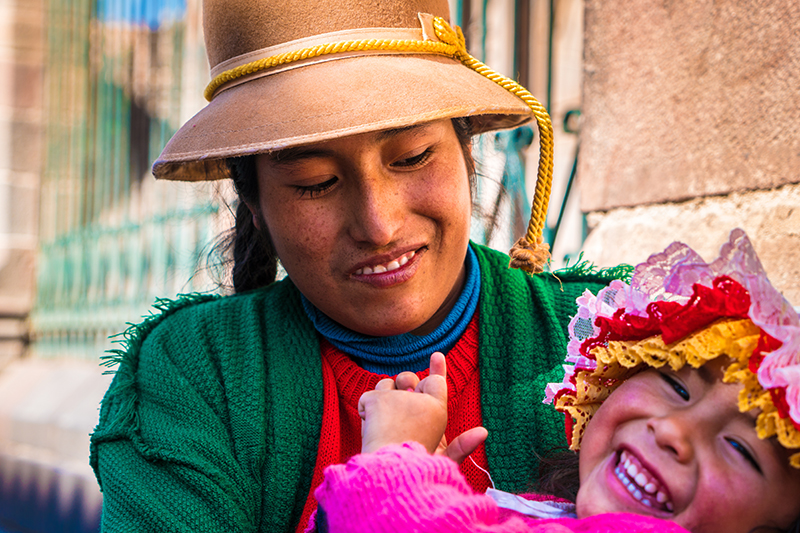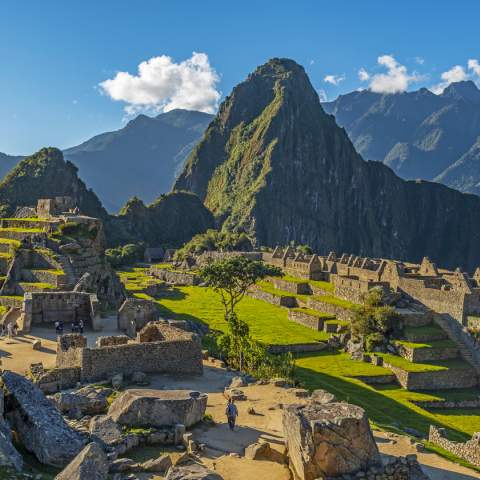03/08/2019

The history of women in Peru is not a simple straight-line narrative. It is a complex, intertwined, multi-cultural story across the centuries that continues to evolve and progress, from ancient traditions to modern thinking. It’s a story still being uncovered and understood by archaeologists. It’s a story being experienced by the more than 15 million women who live in Peru today. It’s a story shared across generations, shared through traditions like textile weaving. It’s a story being written still, as the next generation of Peruvian women, like the women of Manuela Ramos Movement, continue to move it forward.
It’s a story to be told by the women of Peru themselves, which is why we’ve introduced our new Peru Women’s Adventure, an all-women trip that's crafted by women, guided by women, just for women.
The story begins with the Andean civilizations, the patchwork of cultures that developed in the coastal deserts of Peru. New evidence suggests these cultures were not always purely patriarchal. Recently, archaeologists have found evidence that women in Peru had held positions of power and prestige in some of the earliest stages of civilization in the region. At an Àspero archaeological site, a female skeleton was found decorated with shells from hundreds of miles away and accessories made of carved bone, all status symbols in this early civilization. Researchers also discovered sculpted female figurines from more than 4,500 years ago that provide some evidence that women occupied prominent social positions in their societies.
Andean tradition even held that women could inherit property from their mothers, among other allowances. However, after the Spanish conquered the Inca Empire, the relatively egalitarian existence of men and women took a back seat to a society many have described as essentially “machista.”
In the centuries since the arrival of the Conquistadors, patriarchal rule became a firmly established norm throughout the country, though the specifics, tradition and rigidity of the customs and practices vary from group to group. Today, rural women continue to see the most significant gap in gender equality throughout Peru, with the vast majority of rural women working in farming and carry out household chores.
And traditional assumptions and misconceptions about women’s roles in society and at home continue to hold women back. For instance, only about a third of Peruvian girls graduate from secondary school, with a significant gap between rural and urban attendance, often due to access.
Though with that said, Peru has made some strides in recent decades towards a more level playing field. In the 1990s, the country reformed its customary laws – which are followed primarily in indigenous and rural communities – that had previously limited women’s right to work and access banking and financial services, as well as own inherited assets. This helped to drive a 15 per cent increase in labor force participation within the first decade of the changes and amendments made to Peruvian law. From 2000 to 2014, labor force participation for women in Peru increased by 10 per cent, a level ahead of most other countries in South America and Central America over that same time period.
Yet women in Peru are still facing many of the same long uphill battles and constraints women the world over face, even once gaining improved access to the labor force, as they tend to be segregated into lower paying jobs. Perhaps even more significant is the large portion of women, an estimated 60 per cent of all women workers in Peru, who work in the informal sector – which is neither taxed nor monitored by the government – and are unable to scale their businesses or bring them into the formal economy, which deprives them of the government policies designed to promote and protect women such as maternity leave, health coverage and retirement benefits.
However, these are only the facts and figures of a much deeper and fascinating history and ongoing story of women in Peru. Explore deeper, taken on a journey by Peruvian guides who share their thoughts and feelings on the present and future for women in Peru, while shining a light on a compelling and complicated history.
Call Lisa at 1- 877-784-5400 today to join this special Peru Women's Adventure from September 14 to 21, 2019.Submitted by Zach on Fri, 03/08/2019 - 9:17am

The history of women in Peru is not a simple straight-line narrative. It is a complex, intertwined, multi-cultural story across the centuries that continues to evolve and progress, from ancient traditions to modern thinking. It’s a story still being uncovered and understood by archaeologists. It’s a story being experienced by the more than 15 million women who live in Peru today. It’s a story shared across generations, shared through traditions like textile weaving. It’s a story being written still, as the next generation of Peruvian women, like the women of Manuela Ramos Movement, continue to move it forward.
It’s a story to be told by the women of Peru themselves, which is why we’ve introduced our new Peru Women’s Adventure, an all-women trip that's crafted by women, guided by women, just for women.
The story begins with the Andean civilizations, the patchwork of cultures that developed in the coastal deserts of Peru. New evidence suggests these cultures were not always purely patriarchal. Recently, archaeologists have found evidence that women in Peru had held positions of power and prestige in some of the earliest stages of civilization in the region. At an Àspero archaeological site, a female skeleton was found decorated with shells from hundreds of miles away and accessories made of carved bone, all status symbols in this early civilization. Researchers also discovered sculpted female figurines from more than 4,500 years ago that provide some evidence that women occupied prominent social positions in their societies.
Andean tradition even held that women could inherit property from their mothers, among other allowances. However, after the Spanish conquered the Inca Empire, the relatively egalitarian existence of men and women took a back seat to a society many have described as essentially “machista.”
In the centuries since the arrival of the Conquistadors, patriarchal rule became a firmly established norm throughout the country, though the specifics, tradition and rigidity of the customs and practices vary from group to group. Today, rural women continue to see the most significant gap in gender equality throughout Peru, with the vast majority of rural women working in farming and carry out household chores.
And traditional assumptions and misconceptions about women’s roles in society and at home continue to hold women back. For instance, only about a third of Peruvian girls graduate from secondary school, with a significant gap between rural and urban attendance, often due to access.
Though with that said, Peru has made some strides in recent decades towards a more level playing field. In the 1990s, the country reformed its customary laws – which are followed primarily in indigenous and rural communities – that had previously limited women’s right to work and access banking and financial services, as well as own inherited assets. This helped to drive a 15 per cent increase in labor force participation within the first decade of the changes and amendments made to Peruvian law. From 2000 to 2014, labor force participation for women in Peru increased by 10 per cent, a level ahead of most other countries in South America and Central America over that same time period.
Yet women in Peru are still facing many of the same long uphill battles and constraints women the world over face, even once gaining improved access to the labor force, as they tend to be segregated into lower paying jobs. Perhaps even more significant is the large portion of women, an estimated 60 per cent of all women workers in Peru, who work in the informal sector – which is neither taxed nor monitored by the government – and are unable to scale their businesses or bring them into the formal economy, which deprives them of the government policies designed to promote and protect women such as maternity leave, health coverage and retirement benefits.
However, these are only the facts and figures of a much deeper and fascinating history and ongoing story of women in Peru. Explore deeper, taken on a journey by Peruvian guides who share their thoughts and feelings on the present and future for women in Peru, while shining a light on a compelling and complicated history.
Call Lisa at 1- 877-784-5400 today to join this special Peru Women's Adventure from September 14 to 21, 2019.
Most Popular Peru Trips & Tours
| Trip | Price | Days | Highlights |
|---|---|---|---|
| Alternative Inca Trail | $3,995 | 10 Days | Cusco, Ancient Inca Trail , Machu Picchu, Local Perspective , Off the beaten Trek |
| Amazon & Machu Picchu | $3,295 | 9 Days | Amazon Rainforest & Jungle, Amazon Wildlife, Sacred Valley of the Incas, Machu Picchu |
| Classic Inca Trail | $3,995 | 10 Days | Lima, Cusco , Inca Trail Trek, Machu Picchu, Sacred Valley |
| Experience Machu Picchu | $2,995 | 7 days | Lima, Sacred Valley, Cusco, Machu Picchu |















